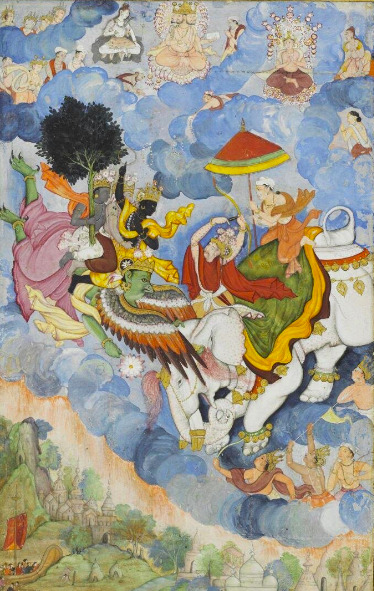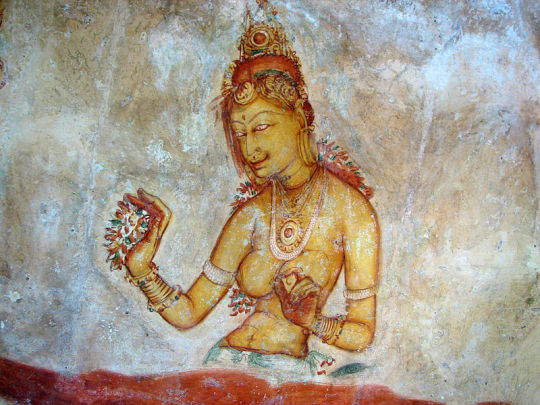#sankhya philosophy
Explore tagged Tumblr posts
Text
Exploring the Mind-Body Connection: Insights from Yoga and Neuroscience
Discover how the ancient wisdom of yoga sutras and the insights from modern neuroscience can deepen your understanding of the mind, consciousness, and the intricate connection between our inner selves and the external reality we perceive.
Exploring the Mind-Body Connection: Insights from Yoga and Neuroscience Exploring the Mind-Body Connection: Insights from Yoga and Neuroscience Have you ever wondered about the intricate relationship between the mind and the body? How does our consciousness perceive and interact with the world around us? In this blog post, we’ll delve into a fascinating neuroscientific study based on the…

View On WordPress
#ancient wisdom#annabackacupuncture#consciousness#malibu#mind#mind-body connection#modern research#neuroscience#neuroscientific perspective#ogden#pain#Patanjali#san pedro#Sankhya philosophy#south shores#transformative power#wellness#yoga#Yoga Texts Corpus#yogic journey
2 notes
·
View notes
Text
Sankhya Philosophy: Understanding the Bhagavad Gita's Teachings on Reality
The Bhagavad Gita, a sacred text within the Indian epic Mahabharata, is a profound dialogue between Lord Krishna and the warrior prince Arjuna. Among the various philosophical perspectives presented in the Gita, the Sankhya philosophy holds a significant place. Sankhya, meaning "enumeration" or "counting," is a school of thought that delves into the nature of reality, the self, and the ultimate purpose of life. In this exploration, we will unravel the key tenets of Sankhya philosophy as elucidated in the Bhagavad Gita.

Sankhya Philosophy:
Principles of Prakriti and Purusha: Sankhya philosophy posits the existence of two fundamental entities - Prakriti and Purusha. Prakriti represents the material world, including the physical and mental realms, while Purusha symbolizes the eternal, unchanging essence or consciousness. The interplay between these two principles is central to understanding the dynamics of existence.
Evolution of the Material World: According to Sankhya, Prakriti undergoes constant evolution, giving rise to the myriad forms and phenomena in the universe. The three gunas - sattva (goodness), rajas (passion), and tamas (ignorance) - are inherent qualities of Prakriti that shape the diversity and characteristics of the material world.
The Concept of the Self (Atman): Purusha, on the other hand, is distinct from the changing material world. It is the unchanging, eternal Self or Atman. The individual self, or Jivatman, is considered a fragment of the supreme, universal Purusha. Realizing the distinction between the eternal self and the transient material world is crucial for spiritual awakening.
Pathways to Liberation: Sankhya philosophy in the Bhagavad Gita introduces the concept of self-realization as the path to liberation (moksha). Arjuna is encouraged to discern the difference between the physical body (Prakriti) and the eternal self (Purusha). The practice of discernment, known as viveka, is fundamental in attaining liberation.
Detachment and Action: Sankhya philosophy advocates a path of detached action (karma yoga) as a means to realize the self. By performing one's duties without attachment to the results, an individual can overcome the cycle of birth and death and attain spiritual freedom.
Conclusion:
The Sankhya philosophy in the Bhagavad Gita provides a profound understanding of the nature of reality, the self, and the path to liberation. It encourages individuals to transcend the illusions of the material world, recognize the eternal nature of the self, and engage in actions with a sense of detachment. The teachings of Sankhya philosophy offer timeless wisdom that continues to inspire seekers on the spiritual journey, guiding them toward a deeper comprehension of the self and the ultimate reality. To know more visit us at
#Sankhya Philosophy#BhagavadGita#GitaWisdom#SpiritualTeachings#KrishnaConsciousness#SacredTexts#Philosophy#DivineWisdom#SelfRealization#SankhyaPhilosophy#GitaStudy#Mindfulness#VedicWisdom
0 notes
Text
Learn Sankhya Philosophy with the Sanskrit Text Sankhya Karika - Part I - HUA
This course is the first of a two-part series on Sankhya Darshana (Philosophy), based on the Sanskrit book 'Sankhya Karika' by Ishvara Krishna. It is a short book with just 72 Karikas, which are short verses that explain Rishi Kapila's Sankhya Darshana. It is very important to understand the basic ideas of Sankhya philosophy if you want to understand other Sanskrit works like the Bhagavad Gita and other Vedic philosophical systems like Yoga and Vedanta.
Sankhya Darshana through the Sankhya Karika – Part I Contents of the course:
It is said, "na hi Sankhya samam gyanam, na hi yoga samam balam" i.e., There is no knowledge like Sankhya, and there is no power like Yoga. Sankhya Darshana was one of the first ways of thinking that tried to find a permanent answer to problems like birth and death, getting old, getting sick, and being sad. In his search for a permanent answer, Sankhya came up with a deep way of thinking about the universe and where humans fit into it. Sankhya thought that a good understanding of the twenty-five Tattvas, which are the basic building blocks of the universe, would lead to a complete and permanent end to human suffering.
In this two-course set, the Sankhya Karika of Ishvara Krishna will be used to teach the basic ideas of Sankhya philosophy. In the first course, we will look closely at Karikas 1–30.
A karika is a name used in the field. It generally has two lines, like the shlokas in the Bhagavad Gita. So, in the first quarter, we will cover about half of the Sankhya Karika. The last 42 Karikas will be taught in the second course in the series. Students will learn new things about Sankhya philosophy, which many scholars mistakenly call a dualistic, atheistic theory.
You don't need to know anything about Sanskrit or Sankhya philosophy to take this course. The students will get a PDF file with each karika written in both Devanagari and Roman writing, along with the word meanings and short explanations. PDF files will also be made available for extra reading materials.
The goals of this course are for students to be able to:
a) Understand the basics of Sankhya Philosophy.
b) Learn all the technical Sanskrit words you need to know.
c) Learn the basics so that you can also understand works like the Upanishads and the Bhagavad Gita.
d) Learn to appreciate other philosophical schools and be motivated to learn more about Vedic systems like Vedanta, Mimamsa, Yoga, Nyaya, and Vaisheshika.
e) Get a deep understanding of the ideas of "mind," "atma," "ego," and "intellect," as well as how the world came to be.
Structure of the class:
Each week, there will be at least one 90-minute contact hour with one or more teachers. The class is set up so that each week's self-study and reflection can lead to talk and debate. Even though each class will only talk about the same topic for 60 minutes, the conversation time will be open-ended and can go on for up to 30 more minutes. Students will have to take notes on the Karikas that were talked about. They don't have to be as good as papers written for school, but they should be based on what the student has learned and understood so far.
Enroll Course
CONTACT — 407–205–2118
Overview >> Hindu University Of America
EMAIL- [email protected]
Address- 5200 Vineland Rd 125 Orlando, FL 32811
0 notes
Photo




Cracks by Jordan Scott (2009)
A soul element thus disguised in outer form, but which reveals itself as soul, dwells in the Sattva [astral] element. A soul element immersed in form, but which is, so to say, entangled in it and cannot emerge from it, dwells in the Tamas- element [physical]; and that in which, more or less, the soul element and its outer expression in form, are, to a certain extent, balanced, dwells in the Rajas-element [etheric]. Sattva, Rajas, Tamas, the three Gunas, pertain to the essential characteristics of what we know as Sankhya philosophy.
Thus Sankhya is a contemplation of the sheaths of the soul, and Yoga the guidance of the soul to higher and ever higher stages of inner experience. To devote oneself to Yoga means a gradual awakening of the higher forces of the soul so that it experiences something not to be found in everyday life, which opens the door to higher and higher stages of existence.
—Rudolf Steiner, The Bhagavad Gita and the Epistles of St. Paul
#Cracks#Cracks (2009)#Jordan Scott#Eva Green#India#spiritual science#anthroposophy#Sankhya#philosophy#the gunas
3 notes
·
View notes
Text
Oh! It's similar to sankhya/samkhya yoga, if I remember correctly ..... It's a deeeeeeep philosophy. Love it 🪷


521 notes
·
View notes
Text

Sun & Moon OM Guru ॐ
The Chakras: Link Between the Macrocosm and Microcosm
A Powerful Link Between Two Worlds
As we have seen, in keeping with the tantric adage “Tatha brahmande, yatha pindande” (as in the macrocosm, so in the microcosm), each of us, as well as the cosmos, is made up of evolutes of consciousness described by Sankhya philosophy. However, the individual permutations of our minds (due to karma, samskaras, vasanas, and limiting identity) ensure that each of us lives in a self-created world that, while made of the same evolutes, is a distorted version of the divinely created world. Our experience of ourselves reflects not only the dynamics of the macrocosm, but also the acquired tendencies of our mind, resulting in specific expressions of form, function, and behavior. No one else has exactly your facial features or all the unique quirks of your personality, or the exact same collection of interests and preferences.
39 notes
·
View notes
Text





Bhedabhedavada, Advaita Vedanta & Svatantryavada
☀️THE INFLUENCE OF VEDANTA ON INDIAN THOUGHT HAS BEEN PROFOUND. ALTHOUGH THE PREPONDERANCE OF TEXTS BY ADVAITA SCHOLARS HAS IN THE WEST GIVEN RISE TO THE ERRONEOUS IMPRESSION THAT VEDANTA MEANS ADVAITA THE NON-DUALISTIC ADVAITA IS
BUT ONE OF MANY VEDANTA SCHOOLS. BRITANNICA-MATT STEFON
☀️ BHEDABHEDA -
(MONIER-WILLIAMS)
DISUNION AND UNION
DUALISM AND NON-DUALISM
☀️ BHEDABHEDA, SANSKRIT BHEDÄBHEDA ("IDENTITY AND DIFFERENCE") AN IMPORTANT BRANCH OF VEDANTA, A SYSTEM OF INDIAN PHILOSOPHY. ITS PRINCIPAL AUTHOR WAS BHASKARA, PROBABLY A YOUNGER CONTEMPORARY OF THE GREAT 8TH-CENTURY-CE THINKER SHANKARA OF THE ADVAITA (NONDUALIST) SCHOOL. THE MAINSTAY OF BHASKARA'S PHILOSOPHY WAS THE CONVICTION THAT ACTS AND KNOWLEDGE ARE NOT MUTUALLY EXCLUSIVE BUT, RATHER, MUTUALLY REINFORCING.
IN CONTRAST, SHANKARA HELD THAT ULTIMATELY ONLY TOTAL RESIGNATION AND WITHDRAWAL FROM ACTS ARE NECESSARY TO ATTAIN RELEASE (MOKSHA) FROM REBIRTH (SAMSARA). AGAINST THAT VIEW, BHASKARA UPHELD THE DOCTRINE OF THE "CUMULATIVE EFFECT OF ACTS AND KNOWLEDGE" BRITANNICA
☀️SCHOLARS SUCH AS HAJIME NAKAMURA AND PAUL HACKER STATE THAT ADI SHANKARA DOES NOT ADVOCATE VIVARTAVADA AND THAT HIS EXPLANATIONS ARE "REMOTE FROM ANY CONNOTATION OF ILLUSION." ACCORDING TO THESE SCHOLARS. IT WAS THE 13TH CENTURY SCHOLAR PRAKASATMAN WHO GAVE A
DEFINITION TO VIVARTA AND IT IS PRAKASATMAN'S THEORY THAT IS SOMETIMES MISUNDERSTOOD AS ADI
SHANKARA'S POSITION.
ANDREW NICHOLSON CONCURS WITH HACKER AND OTHER SCHOLARS, ADDING THAT THE VIVARTA-VADA ISN'T SHANKARA'S THEORY THAT SHANKARA'S IDEAS APPEAR CLOSER TO PARINAMA-VADA, AND THAT THE VIVARTA EXPLANATION LIKELY EMERGED GRADUALLY IN ADVAITA SUBSCHOOL LATER. WIKIPEDIA
☀️ SVATANTRYAVADA
THE PRATYABHIJNA PHILOSOPHY OF SOMANANDA
REFUTES THE ARAMBHVADA (THE 'REALISTIC VIEW' OF THE NYAYA-VAISESIKA), THE PARINAMAVADA (THE THEORY OF TRANSFORMATION OF THE SANKHYA-YOGA AND THE VIVARTAVADA OF THE THEORY OF THE MANIFESTATION OF THE ADVAITA), BY POSTULATING THE THEORY OF SVATANTRYAVADA (THE 'UNIVERSAL VOLUNTARISM WHICH STATES THAT IT IS DUE TO THE SOVEREIGNTY OF GOD'S WILL THAT EFFECT EVOLVES FROM CAUSE
WIKIPEDIA
#bhedhabheda #svatantrya
#bhedabhedavada#parinamavada#consciousness#presence#svatantrya#advaita vedanta#heart#awareness#spiritual#nonduality#spirituality#divinemother#selfrealization#advaita#shankara#bhaskara#Vivarta#vivartavada
2 notes
·
View notes
Text
2024 Why Practice?
As the new year begins we will embark on a journey through a leisurely study of Sankhya philosophy as a tool to enrich our personal yoga practices. Sankhya is a philosophy rooted in India. It’s prevalent in the bhakti yogic text of the Bhagavad Gita. It’s foundational for the understanding of yoga’s sister discipline – the healing art of Ayurveda. When I attended teacher training – we had…
#Bhagavad gita#infinite mind#meditation#mindfulness#patanjali#Personal Yoga Practice#samkhya#Sankhya#YOGA
1 note
·
View note
Text
Kapila Gita - Conversation between Kapila and Devahuti - Teachings of Lord Kapila, the Son of Devahuti - Introduction
youtube
*🌹 Kapila Gita - Conversation between Kapila and Devahuti - Teachings of Lord Kapila, the Son of Devahuti - Introduction 🌹*
*✍️ Prasad Bharadwaj*
*Kapila Muni, known as the son of Devahuti, explained the philosophy of Sankhya Yoga, which elucidates the relationship between the soul, God, and the material world. He taught that souls are bound by karma in the illusion of the material world, and liberation from these bonds is possible through devotion (bhakti yoga). Kapila Muni emphasized the importance of regulated life and devotion to attain spiritual progress and realization of the Supreme.*
🌹🌹🌹🌹🌹
0 notes
Text
Kapila Gita - Conversation between Kapila and Devahuti - Teachings of Lord Kapila, the Son of Devahuti - Introduction
youtube
🌹 Kapila Gita - Conversation between Kapila and Devahuti - Teachings of Lord Kapila, the Son of Devahuti - Introduction 🌹 ✍️ Prasad Bharadwaj https://youtu.be/9emptj5cmB4 Kapila Muni, known as the son of Devahuti, explained the philosophy of Sankhya Yoga, which elucidates the relationship between the soul, God, and the material world. He taught that souls are bound by karma in the illusion of the material world, and liberation from these bonds is possible through devotion (bhakti yoga). Kapila Muni emphasized the importance of regulated life and devotion to attain spiritual progress and realization of the Supreme.
🌹🌹🌹🌹🌹
0 notes
Text
Kundalini Yoga is a connecting link between Sankhya philosophy and Vedanta philosophy
Friends, nothing can be created from Purusha. It is actually the void sky. The visible empty and physical sky is also not actually the void sky. If the world is considered to have originated from Purusha, then it will be against the basic scientific principle according to which no substance can be created or destroyed, but can only change its form. The world being born from Purusha means being…
0 notes
Text
Exploring the Mind-Body Connection: Insights from Yoga and Neuroscience
Discover how the ancient wisdom of yoga sutras and the insights from modern neuroscience can deepen your understanding of the mind, consciousness, and the intricate connection between our inner selves and the external reality we perceive.
[https://www.ncbi.nlm.nih.gov/pmc/articles/PMC8675243/] Exploring the Mind-Body Connection: Insights from Yoga and Neuroscience Have you ever wondered about the intricate relationship between the mind and the body? How does our consciousness perceive and interact with the world around us? In this blog post, we’ll delve into a fascinating neuroscientific study based on the perspective on the…

View On WordPress
#ancient wisdom#consciousness#mind#mind-body connection#modern research#neuroscience#neuroscientific perspective#Patanjali#Sankhya philosophy#transformative power#yoga#Yoga Texts Corpus#yogic journey
0 notes
Text
Save Nature
Prakriti, a concept rooted in ancient Indian philosophy and spirituality, encompasses the fundamental elements and forces that constitute the natural world. It embodies the essence of all that is natural, from the smallest grain of sand to the vast expanse of the cosmos. In Hinduism, Prakriti is often contrasted with Purusha, the cosmic consciousness or spirit, with Prakriti representing the material universe and its ever-changing forms.
According to Sankhya philosophy, Prakriti is comprised of three gunas or qualities: Sattva (purity, harmony), Rajas (activity, passion), and Tamas (inertia, darkness). These gunas interact dynamically to create and sustain the diversity of phenomena in the universe, including the physical, psychological, and emotional aspects of existence.
Prakriti is not merely the external environment but also includes the internal landscape of thoughts, emotions, and desires. It is the canvas upon which life unfolds, the nurturing mother who provides sustenance and the playground where the drama of existence plays out.
In contemporary contexts, Prakriti serves as a reminder of our interconnectedness with nature and the importance of living in harmony with natural rhythms and cycles. It encourages mindfulness of our impact on the environment and emphasizes the need for sustainable practices that respect and preserve the delicate balance of ecosystems.
Ultimately, understanding Prakriti invites us to recognize the profound unity underlying the apparent diversity of the world, fostering reverence for all life forms and a deep appreciation for the beauty and complexity of the natural world that sustains us all.
1 note
·
View note
Text
Discovering Advaita Vedanta: Exploring Maya, Brahman, and Samsara - HUA
In this Course, Students will inquire into some of the fundamental misunderstandings that have accumulated around the Advaita Vedanta. Is the world to be taken as unreal? Is it a pessimistic philosophy? Is the world to be renounced? Is it only for Sannyasis? Students will be encouraged to form well-informed perspectives on Advaita Vedanta after a deep inquiry facilitated by the study of an original Sanskrit text, Vedantasara of Sadananda, an authoritative Acharya of the Advaita tradition. This study will enable students to form new insights into Advaita Vedanta philosophy.
Vedantasara of Sadananda – Part 1 Course content:
This Course is the first course in a two-part course sequence that introduces Advaita Vedanta systematically based on a text called Vedantasara by Sadananda. Advaita Vedanta is the most dynamic and popular of Vaidika Darshanas (philosophies). It is very well formulated, and it answers our fundamental questions regarding life and our human condition. Although there are many texts that deal with the principles of Advaita Vedanta, Vedantasara is a very good entry level text.
This Text is prescribed at the Graduate levels at universities in India. What Sankhya Karika is to Sankhya philosophy, Vedantasara is to Advaita Vedanta. Composed in Prose form, the Vedantasara consists of forty-two Gadyanshas. Other Texts such as the Brahmasutra, the Bhagavadgita, Upanishads and other Darshanas will become more accessible once the student acquires a firm foundation in Advaita Vedanta.
In the first course, approximately half the text will be covered, and the second course will cover the remaining portion. Prior knowledge of Sanskrit or Vedanta philosophy is not necessary to take up this course. A PDF file of the main text with Devanagari and Roman script will be shared with the students. In addition, supplementary reading material will be shared in PDF form. Through this course, students will also get initiated into the Sanskrit language.
Enroll Course
CONTACT — 407–205–2118
Overview >> Hindu University Of America
EMAIL- [email protected]
Address- 5200 Vineland Rd 125 Orlando, FL 32811
0 notes
Photo


Krishna and Indra (1590) & Apsara at Sigiriya, Sri Lanka
In this illustration to the text done in about 1590, Krishna sweeps down on the bird Garuda to triumph over Indra, the lord of the gods, riding on the white elephant Airavata, watched by gods and celestial beings.
—Victoria & Albert Museum - More on Apsara here.
Devayani: I asked in surprise who you were, and you meekly answered that you were the son of Vrihaspati, a divine sage at the court of the God Indra, and desired to learn from my father that secret spell which can revive the dead.
—Rabindranath Tagore, The Fugitive
The God, Indra, is to be found in the soul world at a time when the Christ was not yet perceptible to Earth evolution, although the Christ light shone upon him. A man who is able to perceive Indra may well say that this Being now reveals something different from his earliest revelations; for at first the Christ light did not ray back from him. Since the point of time in question, Indra has not shed his own light into the spiritual evolution of the earth, but has reflected the light of Christ, just as the moon reflects the light of the sun. The light thus rayed back by Indra, not directly perceptible on earth and in which therefore we cannot actually recognize Christ, was proclaimed by Moses to his people. Moses gave the name of Jahve or Jehovah to this Christ light rayed back by Indra as the sunlight is reflected by the moon. In lectures upon the Gospel of St. John, I have spoken about another aspect of this matter. The Christ is heralded, and Jahve or Jehovah is the name of the Christ light rayed back by an ancient deity. It is a prophetic heralding of Christ. Indra himself passed to a higher stage of evolution through this contact with the Christ light. He did not of course become Jehovah. It is not correct to say that Jehovah is Indra. But we can understand that as Indra manifests himself in lightning and thunder, even so does Jehovah manifest himself therein, because a being can only reflect in accordance with its own nature. Jehovah therefore was manifested in lightning and thunder.
—Rudolf Steiner, The East in the Light of the West
Krishna speaks of the Cosmic Word, of the Creative Word, of the fashioning of existence, of the devotional deepening of the soul, — of Yoga. The same trinity meets us again in another form, only in a more concrete, more living way — in a Being who is Himself to be thought of as walking the Earth — the Incarnation of the Divine Creative Word! The Vedas came to mankind in an abstract form. The Divine Logos, of whom the Gospel of St. John speaks is the Living and Creative Word Itself! That which we find in the Sankhya philosophy, as the law to which the cosmic forms are subject, that, historically transposed into the old Hebrew revelation, is what St. Paul calls the Law. The third stream we find in St. Paul as Faith in the risen Christ. That which was Yoga in Krishna, in St. Paul was Faith, only in a more concrete form — Faith, that was to replace the Law. So the trinity, Veda, Sankhya and Yoga were as the redness of the dawn of that which later rose as sun. Veda appears again in the actual Being of Christ Himself now entering in a concrete, living way into historical evolution, not pouring Himself out abstractly into space and the distances of time, but living as a single Individual, as the Living Word.
—Rudolf Steiner, The Bhagavad Gita and the Epistles of St. Paul
5 notes
·
View notes
Text
La sagesse du Yoga - Jour 148
Dans la philosophie du Sankhya yoga, il existe trois cordes, appelées les trois gunas, qui nous lient à notre expérience terrestre. Les trois gunas sont rajas (énergie ardente et action), tamas (énergie paresseuse et léthargie) et sattva (lumière et équilibre). Idéalement, nous serons dans un état de sattva et à l’aise, sans basculer vers les autres extrêmes.Dans la vie, il est facile de passer…

View On WordPress
0 notes